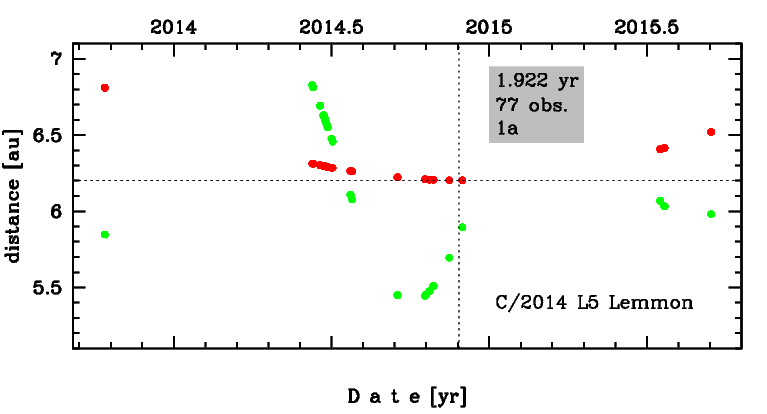C/2014 L5 Lemmon
more info
Comet C/2014 L5 was discovered on 9 June 2014 with with Mount Lemmon Survey, that is 5.5 months before its perihelion passage. Next, it was found on earlier images taken on 12 October 2013 with the Mount Lemmon Survey. This comet was observed until 14 September 2015.
Comet had its closest approach to the Earth on 2 October 2014 (5.4-6 au), almost 2 months before its perihelion passage.
Solution given here is based on data spanning over 1.92 yr in a range of heliocentric distances: 6.81 au – 6.203 au (perihelion) – 6.52 au.
This comet suffers small planetary perturbations during its passage through the planetary system; these perturbations lead to less tight future orbit with semimajor axis smaller than 10,000 au (see future barycentric orbits).
Comet had its closest approach to the Earth on 2 October 2014 (5.4-6 au), almost 2 months before its perihelion passage.
Solution given here is based on data spanning over 1.92 yr in a range of heliocentric distances: 6.81 au – 6.203 au (perihelion) – 6.52 au.
This comet suffers small planetary perturbations during its passage through the planetary system; these perturbations lead to less tight future orbit with semimajor axis smaller than 10,000 au (see future barycentric orbits).
| solution description | ||
|---|---|---|
| number of observations | 77 | |
| data interval | 2013 10 12 – 2015 09 14 | |
| data type | perihelion within the observation arc (FULL) | |
| data arc selection | entire data set (STD) | |
| range of heliocentric distances | 6.81 au – 6.20 au (perihelion) – 6.52 au | |
| detectability of NG effects in the comet's motion | NG effects not determinable | |
| type of model of motion | GR - gravitational orbit | |
| data weighting | YES | |
| number of residuals | 133 | |
| RMS [arcseconds] | 0.40 | |
| orbit quality class | 1a | |
| orbital elements (heliocentric ecliptic J2000) | ||
|---|---|---|
| Epoch | 2014 12 09 | |
| perihelion date | 2014 11 26.35276252 | ± 0.00335704 |
| perihelion distance [au] | 6.20315800 | ± 0.00001342 |
| eccentricity | 1.00271317 | ± 0.00001568 |
| argument of perihelion [°] | 45.610667 | ± 0.000298 |
| ascending node [°] | 35.686581 | ± 0.000043 |
| inclination [°] | 122.807987 | ± 0.000045 |
| reciprocal semi-major axis [10-6 au-1] | -437.38 | ± 2.52 |
